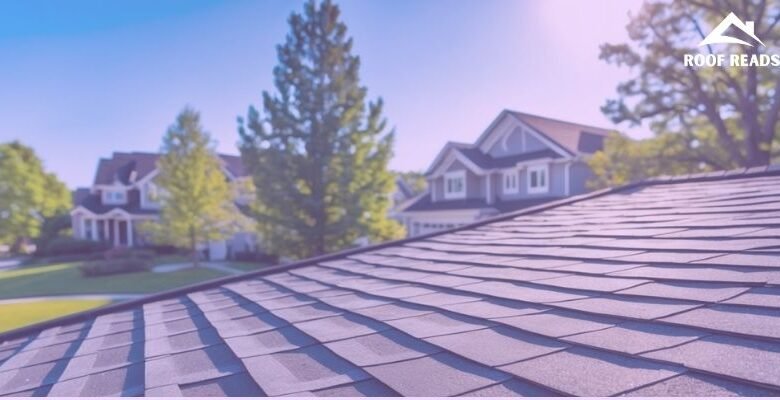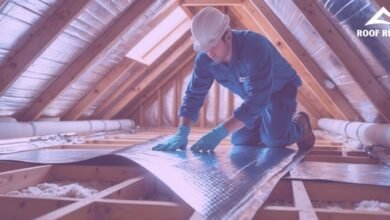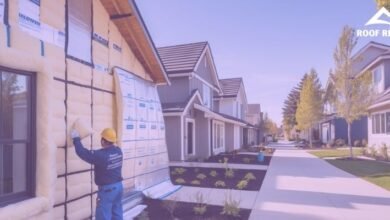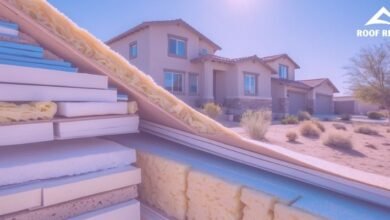How Long Does a Roof Last: Average Lifespan by Material Type

When you’re buying a home or planning a renovation, knowing how long your roof will last is essential for budgeting and peace of mind. Different roofing materials offer varying lifespans, with some lasting just 15 years while others can protect your home for a century or more. On average, a roof will last between 25 to 50 years, though this depends on the material, installation quality, and regular maintenance.
The most common roofing material, asphalt shingles, typically lasts 15-30 years, with 3-tab shingles on the lower end and architectural or premium shingles lasting up to 40-50 years. More durable options include metal roofs (20-70 years), cedar shake roofs (25-40 years), clay tile roofs (about 50 years), and slate roofs, which can last up to 100 years with proper care.
Key Takeaways
- Roof lifespans vary widely from 15 to 100 years depending on the material used and quality of installation.
- Regular maintenance and proper care can significantly extend the life of any roof type.
- Signs of aging like missing shingles, leaks, or sagging indicate it may be time to consider roof replacement.
What Factors Determine How Long a Roof Lasts?

The lifespan of your roof depends on several key elements that work together to protect your home. From the materials you choose to how they’re installed, each factor plays an important role in determining whether your roof will last for decades or require premature replacement.
Quality of Roofing Materials
The materials used in your roof significantly impact its durability. Premium asphalt shingles can last 30-40 years, while basic varieties might only protect your home for 15-20 years.
Cedar shakes outlast many wood options because they naturally resist rot and insects. They can even withstand winds up to 245 miles per hour, making them suitable for extreme weather conditions.
Metal roofing costs more initially but provides three times the lifespan of asphalt shingles. Many metal roofs last 50+ years with minimal maintenance.
Rubber roofing, popular for flat roofs, typically lasts 30-50 years when properly installed. These materials resist weather damage and require little upkeep.
Proper Roof Installation
Even the highest quality materials will fail prematurely if installed incorrectly. Professional installation ensures proper sealing, alignment, and fastening of all roofing components.
Skilled roofers follow manufacturer specifications exactly, which often determines whether warranties remain valid. They also ensure appropriate underlayment installation, which provides a critical secondary moisture barrier.
Proper nailing techniques prevent shingles from lifting during high winds. The correct number and placement of fasteners can mean the difference between a roof that lasts decades and one that fails in the first major storm.
Quality installation also includes proper flashing around chimneys, vents, and valleys—areas most vulnerable to leaks.
Climate and Environmental Conditions
Your local weather significantly affects roof longevity. Homes in extreme climates typically need more frequent roof replacements than those in moderate conditions.
UV exposure gradually breaks down roofing materials, especially asphalt shingles. Southern and southwestern homes often experience faster deterioration due to intense sunlight.
Frequent temperature fluctuations cause materials to expand and contract, creating stress that shortens lifespan. This thermal cycling can crack shingles and create gaps between roofing elements.
Heavy rainfall, snow loads, and high humidity can introduce moisture problems that lead to rot and deterioration. Areas with frequent storms or hurricane exposure place additional stress on roofing systems.
Trees near your home can drop debris that traps moisture and encourages moss growth, potentially reducing roof life by years.
Roof Design and Ventilation
A roof’s design directly impacts its durability. Steeper slopes shed water more effectively, reducing the chance of leaks and extending lifespan.
Proper attic ventilation prevents heat and moisture buildup that can damage roofing from beneath. Good airflow keeps attic temperatures lower in summer, preventing shingles from baking and curling.
Adequate insulation works with ventilation to maintain consistent temperatures across the roof surface. This prevents ice dams in winter that force water under shingles.
Simple roof designs with fewer valleys and penetrations typically last longer than complex designs. Each cut or join in the roofing system creates a potential entry point for water.
Roof overhangs protect walls from moisture while channeling water away from the foundation, contributing to the overall performance of your roofing system.
Lifespan of Different Roofing Materials

Roofing materials vary greatly in their durability and expected service life. The right choice depends on your budget, climate conditions, and how long you plan to stay in your home.
Asphalt Shingles: 3-Tab, Architectural, and Premium
Asphalt shingles are the most common roofing material in America due to their affordability and decent lifespan. 3-tab asphalt shingles typically last 12-25 years, making them the most economical but shortest-lived option. They come with warranties around 10 years.
Architectural shingles (also called laminated or dimensional shingles) offer better durability, lasting 25-40 years with warranties up to 30 years. They’re thicker and have a more textured appearance.
Premium asphalt shingles can last 20-35 years with 20-year warranties. They often mimic the look of slate or wood shakes while providing better protection.
Factors that affect asphalt shingle lifespan include:
- Climate (extreme temperatures reduce lifespan)
- Roof ventilation quality
- Installation quality
- Maintenance frequency
Metal Roofing: Standing Seam, Ribbed Panels, and Stone-Coated Steel
Metal roofs offer exceptional longevity and durability. Standing seam metal roofs, with their hidden fasteners, typically last 30-50 years. They resist leaks better than other metal roofing types because there are no exposed fasteners to fail.
Ribbed metal panels (exposed fastener systems) last 20-30 years. While less expensive than standing seam, they require more maintenance as the exposed screws may loosen over time.
Stone-coated steel tiles combine durability with aesthetic appeal, lasting 40-70 years. These systems resemble traditional roofing materials but offer metal’s strength.
Metal roofs excel in areas with:
- Heavy snow
- High winds
- Wildfire risk
- Extreme temperature shifts
Slate Roofing and Natural Slate Tiles
Slate roofing represents the gold standard for roof longevity. Natural slate tiles can last an incredible 75-200 years, often outliving the structures they protect. This makes slate the most durable roofing material available.
The exceptional lifespan comes with premium costs – both in materials and installation, as slate is heavy and requires specialized installation knowledge.
Slate roofs require minimal maintenance and provide excellent protection against:
- Fire
- Water damage
- Insect infestation
- Mold growth
Many historic homes maintain their original slate roofs after over a century. The incredible durability makes slate an environmentally friendly choice since replacement happens so rarely.
Tile Roofs: Clay and Concrete Tile
Clay tile roofs offer exceptional durability, lasting 50-100 years when properly maintained. These tiles have been used for centuries in Mediterranean climates and maintain their color well over time. They excel in hot, dry regions.
Concrete tiles typically last 40-75 years. While slightly less durable than clay, they cost less and offer similar benefits. Both materials provide:
- Excellent fire resistance
- Good insulation properties
- Low maintenance needs
- High wind resistance (when properly installed)
Tile roofs require sturdy roof structures due to their weight. The tiles themselves rarely fail, but the underlayment may need replacement every 20-30 years while leaving the tiles intact.
Both clay and concrete tiles develop a patina over time that many homeowners find attractive.
Signs of Aging and When to Replace Your Roof
Knowing when your roof needs replacement can save you from costly water damage and structural problems. Roofs show specific warning signs as they age, which homeowners should monitor regularly.
Visible Damage: Missing Shingles and Granule Loss
Missing or damaged shingles are clear indicators that your roof is deteriorating. Look for shingles that appear curled, buckled, or blistered, as these conditions suggest advanced aging.
Granule loss is another important sign to watch for. Check your gutters and downspouts for accumulation of granules that have washed off the shingles. When shingles lose their protective granules, they become more vulnerable to UV damage.
Dark spots or patches on your roof often indicate areas where granules have worn away. This uneven appearance suggests your roof may be approaching the end of its useful life.
A roof with 10-15% visible damage typically requires replacement rather than repair. Professional roof inspections can help identify these issues before they worsen.
Leaks and Water Intrusion
Water stains on ceilings or walls are obvious signs of roof leaks. Even small stains should not be ignored, as they indicate water has already breached your roofing system.
Check your attic regularly for signs of moisture or light coming through the roof boards. Damp insulation, mold growth, or rotting wood in the attic all point to ongoing water intrusion problems.
Rising energy bills might also signal roof leaks, as water-damaged insulation loses its effectiveness. This causes your heating and cooling systems to work harder.
The age of your roof matters when assessing leaks. If your asphalt shingle roof is over 15-20 years old and showing multiple leak points, full replacement is often more cost-effective than continued repairs.
Impact of Storm Damage
Severe weather events can significantly shorten a roof’s lifespan. After major storms, inspect your roof for new damage like lifted shingles, dents from hail, or debris impact.
Wind damage often appears as shingles that are lifted at the edges or completely torn off. Even if only a few shingles are affected, the protective seal may be broken on many others.
Hail damage creates bruising or small dimples in shingles that may not be visible from the ground. These impacts compromise the shingle surface and accelerate deterioration.
Multiple storms over time have a cumulative effect on your roof’s integrity. Document storm damage for insurance purposes and consider a professional assessment if your area experiences frequent severe weather.
Roof Longevity: Maintenance, Care, and Home Value
Regular maintenance extends your roof’s lifespan while protecting your home’s value. The right care practices can add years to your roof and save thousands in replacement costs.
Best Practices for Roof Maintenance
Regular roof inspections are crucial for maintaining longevity. Experts recommend inspecting your roof at least twice a year, typically in spring and fall. Look for cracked, curled, or missing shingles, which indicate potential problems.
Clear debris like leaves and branches that can trap moisture and cause rot. Trim trees near your home to prevent branches from scraping against shingles during storms.
Clean your gutters regularly to prevent water backup that can damage roof edges. For tile roofs, remove algae, moss, and mold buildup which can deteriorate materials over time.
Professional inspections every 2-3 years can catch issues homeowners might miss. After severe weather events, it’s wise to schedule an extra inspection to identify any new damage.
Role of Ventilation and Insulation
Proper attic ventilation is essential for roof longevity. Good airflow prevents moisture buildup that can rot roof decking and reduces extreme temperature fluctuations that stress roofing materials.
Most homes need both intake vents (usually in soffits) and exhaust vents (at or near the roof peak). This creates natural airflow that helps regulate temperature and humidity levels.
Adequate insulation works with ventilation to maintain consistent temperatures. In winter, it prevents ice dams that can damage shingles and cause leaks.
Check that vents aren’t blocked by insulation or debris. Signs of poor ventilation include excessive heat in the attic, ice dam formation in winter, and premature aging of shingles.
Roof Longevity and Buying a New Home
When purchasing a home, the roof’s condition should be a top consideration. A new roof adds significant value while an aging one represents a major future expense.
Ask for documentation of the roof’s age and maintenance history. Most home inspections include roof assessments, but consider hiring a roofing specialist for a more thorough evaluation.
Factor replacement costs into your budget if the roof is nearing the end of its lifespan. Asphalt shingles typically last 15-30 years, while materials like slate or metal can last 50+ years.
Look for signs of previous repairs as they may indicate ongoing issues. Water stains on ceilings or in the attic can reveal leaks that might not be visible from outside the home.
Frequently Asked Questions
Homeowners often have specific concerns about their roofs’ lifespans and maintenance requirements. These questions address the most common uncertainties about roof durability, environmental impacts, and necessary upkeep.
What is the expected lifespan of a shingle roof?
Asphalt shingle roofs typically last between 15-30 years depending on the quality of materials used. Standard 3-tab shingles usually last 15-20 years.
Architectural or dimensional shingles offer greater durability, often lasting 25-30 years. Premium shingles with Class 4 impact ratings can extend this lifespan to 30-50 years with proper maintenance.
The manufacturer’s warranty period doesn’t always reflect actual lifespan, as warranties often cover materials only and may prorate coverage over time.
What factors affect the longevity of a roof on a house?
Material quality significantly impacts roof longevity, with premium products typically outlasting budget options. Professional installation is equally crucial, as improper techniques can reduce a roof’s lifespan by up to 30%.
Regular maintenance, including gutter cleaning and prompt repairs, prevents small issues from causing major damage. Proper attic ventilation and insulation help regulate temperature and moisture levels, preventing premature aging.
Roof pitch also matters—steeper roofs tend to last longer as they shed water and debris more effectively than flatter ones.
How do climate conditions in states like Michigan, New York, and Florida impact roof durability?
Michigan and New York roofs face freeze-thaw cycles, heavy snow loads, and ice dams that can stress roofing materials and create water intrusion points. These northern climates often require more robust ice and water shield protection.
Florida roofs contend with intense UV exposure, high humidity, hurricane-force winds, and torrential rains. Metal and tile roofs often perform better in this environment than standard asphalt shingles.
Coastal areas in any state face additional challenges from salt spray, which can accelerate deterioration of metal components and some roofing materials.
What does the term ’30-year roof’ actually imply about its lifespan?
A “30-year roof” refers to the manufacturer’s warranty period, not a guaranteed lifespan. This rating assumes ideal installation and perfect maintenance in moderate climate conditions.
Most 30-year rated roofs typically last 20-25 years in real-world conditions. Environmental factors, installation quality, and maintenance practices all affect the actual longevity.
Homeowners should view these ratings as comparative tools between products rather than exact predictions of how long their specific roof will last.
What considerations should be taken into account when purchasing a house with an older roof?
Buyers should request documentation of the roof’s age, previous repairs, and warranty information. A professional roof inspection is essential to identify existing damage and estimate remaining lifespan.
Replacement costs should factor into purchase negotiations, especially if the roof is nearing the end of its expected lifespan. Insurance companies may require roof certification or replacement before issuing a policy on homes with older roofs.
Buyers should also check for signs of interior water damage that might indicate ongoing roof issues, such as stains on ceilings or walls.
How often should a roof be inspected or maintained to ensure its longevity?
Professional roof inspections are recommended at least once every 1-2 years, with additional checks after severe weather events. Homeowners should also perform visual inspections from the ground using binoculars several times annually.
Maintenance tasks include removing debris from valleys and gutters, trimming overhanging branches, and addressing moss or algae growth promptly. Small repairs should be handled immediately to prevent water intrusion and structural damage.
Maintenance records should be kept for warranty purposes, as many manufacturers require proof of regular care to honor their guarantees.




